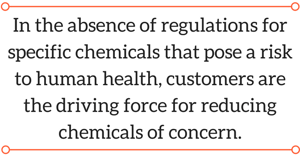Prior to the Sustainable Brands Vancouver Conference, we caught up with Olivia Fritz, an Environmental Project Engineer at Kohler, Co. to learn more about key drivers and future trends for product transparency.
What is the key driving factor towards more transparency, within your organization and the greater economy? Do you foresee full transparency as something that will be required or expected of suppliers in the future?
OF: An increase in customer requests has been a key driving factor towards more transparency at Kohler Co. If sustainability is important to a business, internal transparency about the environmental impacts and potential material hazards is crucial when using a life cycle perspective. Without internal transparency, the business cannot purposefully Design for Environment with an understanding of what truly creates better outcomes both from an environmental and human health perspective.

In terms of the greater economy, there is heightened awareness around this topic due to health issues that may be attributed to humans' increased contact with chemicals. We don’t always know how a material will affect us until many years after it has been in use. The green building industry has been a major driver towards transparency as well. Full transparency will be expected of suppliers in the future, and some companies already vet their suppliers based on their willingness to be transparent. The number of green buildings or buildings that have sustainable design aspects will likely continue to increase and drive demand for both environmental and material transparency. Just like a food nutrition label is required, might building material labels be required in the future?
What is your biggest challenge to redesigning products to include safer materials?
OF: Kohler’s largest challenge to redesigning products to include safer materials is first understanding what “safer” means as related to our products. Materials can have significantly different impacts during a product’s life cycle, from raw material extraction to end of life. Also, we must acknowledge that the materials currently in use are chosen for their specific material properties. A material cannot always easily be replaced without considering cost, quality, and other key factors. We must design products making sure to take a holistic approach.
 For example, if a material change is made but a product’s lifespan decreases significantly, how does that affect the long-term environmental impacts for that product? This is just one example of a question I see us facing as we wrestle with product material health decisions.
For example, if a material change is made but a product’s lifespan decreases significantly, how does that affect the long-term environmental impacts for that product? This is just one example of a question I see us facing as we wrestle with product material health decisions.
Do you see an overlap with chemicals management and sustainability initiatives (e.g. regulatory compliance, LCA, materials health)?
OF: Chemical management has typically been focused on regulatory compliance, but by integrating it with sustainability initiatives, a business can take a proactive approach and create awareness around chemicals with known hazards. This allows a company to potentially stay ahead of chemical regulatory issues or at least begin to research alternatives before regulations take effect.
How do you set goals for making your supply chain more sustainable? Is it vendor-specific, chemical-specific, or more of an overall goal (e.g. reducing high priority chemicals by a certain percent by a particular date)?
OF: Kohler is just beginning to dive deeper into supply chain sustainability and build an integrated program. We are bench-marking against others’ programs and are planning to test our Design for Environment (DfE) program with specific suppliers during New Product Development (NPD). We’re taking a multi-pronged approach by working intensively with some suppliers through our NPD process with DfE, while also assessing the impact of the majority of our supply base through surveys and scorecards.
To get a baseline, our current goals focus on understanding what kind of impact our suppliers make up, rather than a specific reduction. An overall goal will come later once we have built our program and have cross-functional buy-in. This will be vender specific based on factors including material impact, type and size of supplier. For materials specifically, we are beginning to work with engineering and suppliers to specify materials that do not contain chemicals of concern.
What do you see as the driving force(s) for eliminating/ reducing chemicals of concern in the absence of US federal regulations?
 OF: In the absence of regulations for specific chemicals that pose a risk to human health, customers are the driving force for reducing chemicals of concern. Products are created to meet a market demand, so if the market is pushing for products without specific chemicals, this helps support the need to devote resources towards this initiative. At the same time, customers must understand that it’s not always easy to find alternatives that provide the same functions as the current material. There is still a lot of education needed internally and externally around the topic of product material health. This is a complex subject, especially since there is no toxicity data for the majority of chemicals.
OF: In the absence of regulations for specific chemicals that pose a risk to human health, customers are the driving force for reducing chemicals of concern. Products are created to meet a market demand, so if the market is pushing for products without specific chemicals, this helps support the need to devote resources towards this initiative. At the same time, customers must understand that it’s not always easy to find alternatives that provide the same functions as the current material. There is still a lot of education needed internally and externally around the topic of product material health. This is a complex subject, especially since there is no toxicity data for the majority of chemicals.

Olivia Fritz is an Environmental Project Engineer in Kohler Co.’s Product Sustainability Engineering team. She's responsible for managing product transparency for EPDs and material health disclosures, as well as integrating product material health initiatives into Design for Environment.
She's inspired by the challenge to show others how sustainability is connected to their role, no matter what they do. The issues that sustainability addresses impact everyone and we all have an opportunity and responsibility to get involved.
